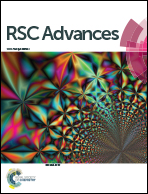Synthesis of magnetic Fe3O4/polyamine hybrid microsphere using O/W/O Pickering emulsion droplet as the polymerization micro-reactor†
Abstract
In order to obtain a magnetic polyamine microsphere, a magnetic oil–water-in-oil multiple emulsion droplet was used as the micro-reactor and template for polymerization. The influences of magnetite (NanoFe3O4) and the polymer precursor polyethyleneimine (PEI) on the properties of an emulsion were investigated. After using hydrophobic CaCO3 nanoparticles (SM-CaCO3) in the emulsification, the liquid paraffin-in-water emulsion stabilized by NanoFe3O4 and PEI was changed to an O/W/O Pickering emulsion. The investigation found that suspensions of 2 wt% SM-CaCO3 in liquid paraffin should be emulsified with 1 wt% NanoFe3O4 in 20 wt% PEI solution at a ϕw of 0.5 in order to incorporate as much PEI as possible, in emulsion droplets, while avoiding the phase inversion of emulsion. After the crosslinking of PEI in the emulsion droplets by glutaraldehyde, a magnetic Fe3O4/polyamine microsphere with both hydrophilic and hydrophobic characteristics was obtained. The microsphere demonstrated an isoelectric point of 9.6. The magnetic capacity of NanoFe3O4 decreased as a result of being trapped in the polyamine matrix of the microsphere.


 Please wait while we load your content...
Please wait while we load your content...